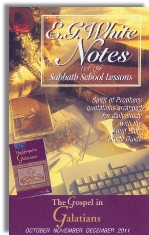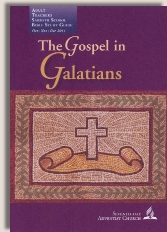|
||||||||||||||
Commentary on "Paul's Authority and Gospel"
Day 4: Tuesday, October 4, 2011 - Paul's Gospel
Overview
The lesson remarks that Paul’s salutation in Galatians includes his signature linking of “Grace” and “peace”, a combination of words that “basically describe[s] his gospel message”. The lesson further remarks that Paul has little space to develop “the nature of the gospel” in the first six verses (an artificial division of verses at best), but that he “masterfully describes the essence of the gospel in only a few short verses.” The lesson then asks what the central truth is upon which the gospel resides.
The author points out that it’s not our conformity to law upon which the gospel hangs but on what “Christ accomplished for us through His death on the cross and resurrection from the dead.”
The lesson ends with an assignment for the reader to write down his or her understanding of the gospel and bring those words to Sabbath School next Sabbath.
Observations
“Grace and peace” do not describe Paul’s gospel message; rather, they identify the fruit of his gospel. This focus on “grace and peace” is not “wrong”, but it deflects from the real significance of how Paul opens this first of his epistles.
The lesson fails to identify the fact that Paul does, indeed, outline the entire gospel in the first four verses of Galatians. In his defense of his apostleship, Paul articulates the core of the power of the gospel: he received his calling not from men but “through Jesus Christ and God the Father, who raised him from the dead” (v. 1). In verse four Paul states the incomparable sacrifice that made the resurrection possible: the Lord Jesus’s volitional giving of Himself as the payment for sin.
These things ARE the gospel. Paul clearly states the gospel in 1 Corinthians 15:3-4:
For I delivered to you as of first importance what I also received: that Christ died for our sins in accordance with the Scriptures, that he was buried, that he was raised on the third day in accordance with the Scriptures…
There is nothing more that constitutes the gospel than these facts: Jesus died, was buried, and rose from the dead on the third day. Period. That IS the gospel that Paul preached, and he clearly articulates it in his greeting to the Galatians.
For the lesson to say that Paul didn’t have much room to develop the nature of the gospel is to reveal that the author does not know the gospel. Adventism teaches another gospel…a “gospel” that includes demonstrating one’s “love” by law-keeping and Sabbath-honoring.
While the lesson correctly states that Christ’s death and resurrection did something we could never do for ourselves, it deviates from biblical truth by stating that “the gospel rests fully on what Christ accomplished for us through His death on the cross and resurrection from the dead.”
This statement clearly says that the “gospel” is something more than Christ’s death and resurrection. It actually states that the “gospel”, whatever it is (which the lesson states Paul did not have space to develop in the greeting) “rests fully on” Christ’s death ad resurrection. Something not identified but named “the gospel” rests on Christ’s sacrifice and rising from the dead.
The Bible, however, clearly states that the gospel is simply this: Christ died, He was buried, He rose from the dead. There is no “gospel construct” that rests on these facts. Rather, the gospel is, purely and simply, these facts.
The lesson’s author very cleverly camouflaged his language to conceal the fact that Adventism teaches that the gospel includes the Sabbath and the upholding of the law. But, if one actually analyzes the words, one sees that this lesson reveals that the author does not accept the pure biblical definition of the gospel. In fact, it encourages the readers to write their own definitions of the gospel for the purpose of sharing and comparing them in class.
Instead of emphasizing the clear purity of the simple gospel, this lesson introduces the cloudy confusion that describes the Adventist “gospel”, leaving the reader with the feeling that the death and resurrection of Jesus are important, but they’re merely the podium upon which the gospel—whatever it is—rests.
This lesson denies the sufficiency of Jesus’ death and resurrection for the forgiveness of all our sins, past, present, and future. There is nothing more to be added to the gospel—and the rest of chapter one and the book of Galatians explains this miraculous fact.
Summary
- The lesson falsely states that Paul did not have space to articulate the gospel in the greeting to the Galatians.
- Paul did state the gospel: Jesus was raised from the dead, and “He gave Himself for our sins to deliver us from the present evil age.”
- The gospel does NOT rest on Jesus’ death and resurrection: rather, Jesus’ death and resurrection ARE the gospel.
- The lesson camouflages the fact that the Adventist gospel is not summed up in Jesus’ death resurrection but includes the upholding of the law.
- This lesson deceptively confuses the definition of the gospel and leads the reader to accept the idea that some other piece remains to be added to the death and resurrection of Jesus in order to have the “full gospel”.
- The curse Paul levels against the teachers of false gospels in verses 6-10 of this chapter of Galatians actually applies to the teachers of the Adventist gospel, and this lesson begins to reveal the subtlety of the Adventist deception.
Copyright 2011 BibleStudiesForAdventists.com. All rights reserved. Revised October 2, 2011. This website is published by Life Assurance Ministries, Glendale, Arizona, USA, the publisher of Proclamation! Magazine. Contact email: BibleStudiesForAdventists@gmail.com.
The Sabbath School Bible Study Guide and the corresponding E.G. White Notes are published by Pacific Press Publishing Association, which is owned and operated by the Seventh-day Adventist church. The current quarter's editions are pictured above.
Official Adventist Resources
Standard Edition Study Guide Week 2
Teacher's Edition Study Guide Week 2
Easy Reading Edition Study Guide Wk 2
Search the Complete Published Ellen G. White Writings
Please Support This Project


